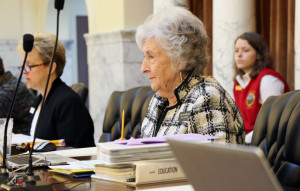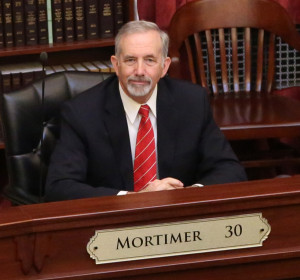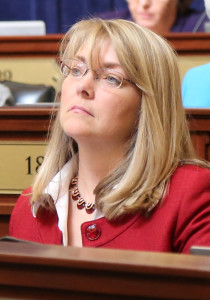The Legislature’s joint budget committee is drafting a 7.4 percent increase in public school spending, the committee’s co-chairwoman said.
The Joint Finance-Appropriations Committee will write the 2016-17 K-12 budget Monday.

Seven or eight JFAC members are drafting a budget to boost public school spending by $110.9 million, or 7.4 percent, said Rep. Maxine Bell, R-Jerome, the committee’s House co-chair.
That’s slightly smaller below the 7.9 percent boost Gov. Butch Otter recommended, and Superintendent of Public Instruction Sherri Ybarra’s proposed 7.6 percent increase.
“But all the (budget) elements are all in it,” Bell said. “There is a little difference in the line items. But there is a big increase and it’s an active budget.”
A 7.4 percent increase would be in line with last year’s 7.4 percent bump. Public education is Idaho’s largest general fund expense.
JFAC’s budget could fall below the requests from Otter and Ybarra, for several reasons.
- Otter underestimated the cost of enrollment increases. Otter based his 2016-17 budget around funding 120 new classrooms, or support units. But Bell and a fellow JFAC member, Rep. Wendy Horman, said enrollment is expected to grow by 167 units.
- Lawmakers are fighting for scarce dollars as state revenue collections trail year-to-date projections by $14 million, due in part to a slow December.
- Some lawmakers want to slow government spending and save funding for higher education and the corrections budgets, “So I have to put limits in there,” Bell said Wednesday.
But Bell stressed schools will not go begging.
“I don’t need to make any excuses for these education budgets,” she said. “They are the first in priority each time, and we strive to do the best we can for those children.”
What will be funded?
Horman, Bell and Senate Education Committee Chairman Dean Mortimer said they have the support needed to increase teacher pay and to reverse recession-era cuts to districts’ discretionary spending, sometimes called operations funding.

For the first time since 2008-09, lawmakers are prepared to set discretionary spending at $25,696 per classroom, up from $23,868.
“Right now, in times of increasing health insurance premiums and increasing utility costs, districts have not had the flexibility they have needed and that category has been reduced during the recession,” said Mortimer, an Idaho Falls Republican who also sits on JFAC.
He emphasized total discretionary funding is increasing beyond 2009 levels, because the number of classrooms has increased over seven years.
Lawmakers are committed to funding the second year of teacher pay raises under the 2015 career ladder law. They are also prepared to increase salaries for pupil-services staff by placing them on the career ladder.
Other initiatives, including a $5 million increase the Idaho Opportunity Scholarship, received funding in the State Board of Education budget JFAC set Thursday.
There are several other priorities, and Horman has developed detailed spreadsheets identifying priorities favored by Otter, Ybarra and the major education groups.
“One of the challenges is taking into account everyone’s opinion and taking all of those opinions and translating them into the budget,” Horman said.
Bell drew on Otter’s 2013 Task Force for Improving Education recommendations to develop her own priorities. She also leans on the leaders of her seven area school districts, who identified discretionary spending as their top priority.
Bell also relies heavily on Horman, who has enough financial acumen and policy understanding “that she could be a budget analyst.”
When it comes down to making judgment calls between Otter’s budget and Ybarra’s budget, Bell said she considers both proposals carefully, but tends to defer to Ybarra.
“This is a lady who has been in the districts, knows the needs of the schools and has her boots on the ground, so to speak,” Bell said.

Horman said the public school budget is the toughest and most important job she faces as a lawmaker.
“I start thinking about the next budget as soon as the session is over,” Horman said. “I visit schools, I listen to parents, I talk to teachers and I meet with the stakeholders. So this is year-round process.”
What is in jeopardy?
Horman and Mortimer both said they haven’t seen enough details about Ybarra’s proposed $300,000 rural schools center to fund it.
The rural schools center is one signature piece of Ybarra’s budget request, and it did not appear in Otter’s budget. Ybarra said it is an essential tool to help ensure rural and geographically isolated school districts can compete with larger districts. Several lawmakers have said they support the concept of extending additional resources to rural districts. But Horman, Mortimer and House Education Chairman Reed DeMordaunt, R-Eagle, want more details first.
Horman also wants a detailed review of services already offered, such as regional mathematics labs, the Idaho superintendents’ network and other programs. Until then, she wants to make sure initiatives aren’t accidentally double-funded.
Lawmakers also question how the center would run from an organizational standpoint, and whether the center’s director or employees would work for the State Department of Education or form a new government agency.
“Do we need an additional layer of government between the school districts and the State Department of Education to provide services out to our schools?’ Horman asked.
Unresolved issues
JFAC’s K-12 budget that emerges Monday will likely come in at less than a 7.4 percent increase.
Bell and Horman said the committee will only budget for new initiatives that have already advanced through the legislative process. That means three pieces of unfinished business probably won’t be funded Monday:
- A rewritten literacy initiative, a centerpiece of Otter’s budget proposal. The governor wants $10.7 million for literacy programs; Ybarra proposed $5 million. Key lawmakers would not divulge their spending plans for literacy programs.
- An increase in bonuses known as leadership premiums, which carries a price tag of nearly $1 million.
- A plan to address “student mobility” — and accommodate enrollment changes that occurs during the year. Otter set aside $3 million to address this issue, but no bill has materialized.
If these proposals pass, budget-writers will run separate “trailer” spending bills to pay for them.
At the beginning of the session, Bell told the education committees that she wanted all of the new policy debates settled in time to write the budget in late February or early March. Bell said she hoped to “send a strong signal to the public that we were serious about education.”
“I was assured there were no pieces that would hold me up on that and they knew that schedule,” Bell said. “Well … things worked more slowly in that area.”
Monday’s budget will address only proposals that have passed both the House and the Senate, Horman said. JFAC will write trailer bills after a new initiatives clears the House or the Senate.
JFAC’s votes only start the budget process. All budget bills must pass the House and Senate, before going to Otter’s desk.
